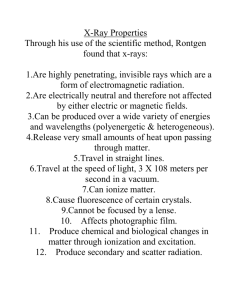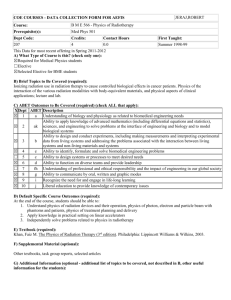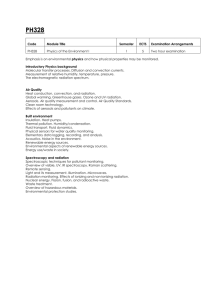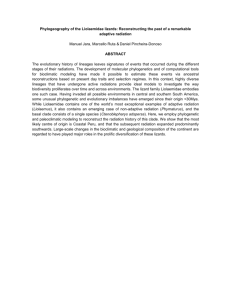CellularGaurdian2
advertisement
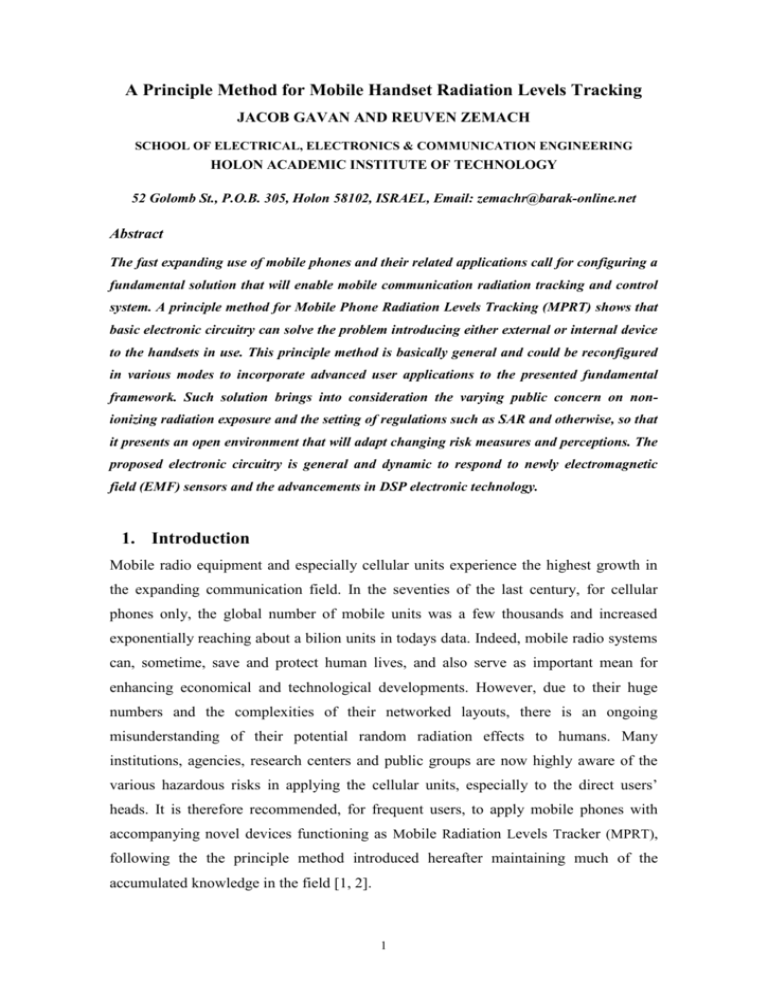
A Principle Method for Mobile Handset Radiation Levels Tracking JACOB GAVAN AND REUVEN ZEMACH SCHOOL OF ELECTRICAL, ELECTRONICS & COMMUNICATION ENGINEERING HOLON ACADEMIC INSTITUTE OF TECHNOLOGY 52 Golomb St., P.O.B. 305, Holon 58102, ISRAEL, Email: zemachr@barak-online.net Abstract The fast expanding use of mobile phones and their related applications call for configuring a fundamental solution that will enable mobile communication radiation tracking and control system. A principle method for Mobile Phone Radiation Levels Tracking (MPRT) shows that basic electronic circuitry can solve the problem introducing either external or internal device to the handsets in use. This principle method is basically general and could be reconfigured in various modes to incorporate advanced user applications to the presented fundamental framework. Such solution brings into consideration the varying public concern on nonionizing radiation exposure and the setting of regulations such as SAR and otherwise, so that it presents an open environment that will adapt changing risk measures and perceptions. The proposed electronic circuitry is general and dynamic to respond to newly electromagnetic field (EMF) sensors and the advancements in DSP electronic technology. 1. Introduction Mobile radio equipment and especially cellular units experience the highest growth in the expanding communication field. In the seventies of the last century, for cellular phones only, the global number of mobile units was a few thousands and increased exponentially reaching about a bilion units in todays data. Indeed, mobile radio systems can, sometime, save and protect human lives, and also serve as important mean for enhancing economical and technological developments. However, due to their huge numbers and the complexities of their networked layouts, there is an ongoing misunderstanding of their potential random radiation effects to humans. Many institutions, agencies, research centers and public groups are now highly aware of the various hazardous risks in applying the cellular units, especially to the direct users’ heads. It is therefore recommended, for frequent users, to apply mobile phones with accompanying novel devices functioning as Mobile Radiation Levels Tracker (MPRT), following the the principle method introduced hereafter maintaining much of the accumulated knowledge in the field [1, 2]. 1 2. Radiation Intensities in Base Stations and Portable Phones Base stations operate at higher power than portable phones, but distances between the radiating antennas and the exposed people are quite large. Usually transmitted radiation power density decreases at a rate greater than the square of the separating distance, and in most cases people are located in the far-field electromagnetic zone of the radiating base station antennas [3]. Thus, total human body exposure to base stations radiation power density is at negligible levels in typical base station output confined by cellular configuration layout in urban areas [3, 4]. For mobile phone the situation is significantly more complex and controversial. In spite of the relatively low radiation transmitted power (usually less than 1 watt), mobile phone users are exposed to higher levels of spatial density radiation than from base station. The most radiating part of a mobile phone is situated at only a few centimeters from the user head, which is the most sensitive area of the human body. In many cases, the antenna base is even touching user ear or head, so that a mobile phone user is exposed to the reactive near field of the phone-radiating antenna, where radiation effects are complex for accurate determination and radiation hot spots are unpredictable. Measurements data show that user head absorbs 30% up to 65% of the transmitted phone radiated power, and only a small percentage can be absorbed by the less sensitive user-hand, and in many cases less than half of the transmitted power is useful to the wireless link [5,6]. Hence, it is far more important to control radiation exposure levels emitted by portable phones than base stations. On the other hand radiation fields effects on users are significantly more complex in portable phones than in base stations, due to the reactive near field conditions [3,7]. The principle method of MPRT takes into consideration the complexity and threats of human body exposure at the near field zone, where fields are reactive. Such method could assist to monitor and alarm on excessive use of electromagnetic radiation towards the head and body of the users and also to economize energy consumption thus extending mobile phone battery life. 2 3. Radiation Effects from Portables Phones Standards of radiation intensity threshold limits of electromagnetic radiation are relatively high, considering security factors and depending on mobile headset transmission frequency range [8]. At resonance frequencies of the human body and head, energy absorption is at maximum. This resonance frequency ranges from 30 MHz for whole body radiation absorption, typical to tall men, up to about 600 MHz for head resonance absorption in young children [9]. The physiological thermal effects of radiation power density penetration and absorption in human head or body are measured in Specific Absorption Rate (SAR) units expressed in W , the transmitted electrical field strength in E kg V and power density in S m W 2 , m represented in far field conditions by: S= E2 Zo (1). In this case, H is the magnetic field intensity given by: H= in E Zo (2), A units, with air characteristic impedance 0 ~ 377 [3]. The equivalent specific m absorption rate is given by: SAR Et 2. 2 (3), where is the conductivity in mho/m, ρ is the volumetric weight density in kg of m3 characteristic human tissues and E(t) is the tangential electric field intensity peak penetrating human tissues skin. This absorbed energy power determine the change in human tissue temperature so that: SAR = c . T t (4), where c is the specific heat, T is the difference of temperature change due to radiation energy absorbed and t is the time of exposure to the absorbed radiating source [7,8]. For near field and especially reactive near field conditions the equations become complex and numerical, statistical and semi-empirical 3D computation methods must be applied. Also, both E and H components must be measured, since Zo in this case is not 3 constant [10. 11]. The weight ρ in SAR indicates that radiation physiological effects should to be stricter for small thin children than for big fat adults [9]. Non-ionizing radiation power density threshold and SAR levels standards as function of the radio frequency are presented in [12, 13] for the occupational case and for the general public. Environmental general public standard threshold limits are 5 times lower in comparison to the occupational ones due to the higher sensitivity given to public health, inhibiting the lack of awareness of the general public to radiation threats. Threats of cellular phone radiation effects are usually higher for teenagers than for adults due to their lightweight (SAR), the longer life-years of exposure to handset radiation and the tendency to talk frequently at longer times. Therefore, radiation effects have complex statistic distribution features, and the probability of exceeding threshold levels is function of exposure time to cell phones [8, 14]. Non-ionizing radiation may have also physiological effects that are not thermal, which may indicate a need for threshold radiation level reduction. Some factors are changes in biological cell growth control mechanisms, indirect induced DNA mutations and changes in calcium efflux, which may occur at even low-level radiation intensity [14]. These generated non-thermal weak power effects resemble for e.g. the emergence of relatively high currents at low power excitation levels in Tunnel Diodes applied in electronic circuits. Scientists stress a concern that low frequency modulation and pulsed peak power applied in modern digital cellular methods increase the probability of nonthermal radiation effects [7, 15]. On the other hand, Digital Signal Processing (DSP) of headsets power control can be arranged in many cases to decrease power density applied and hence lower probability of harmful radiation effects [8]. Recently countries such as Australia, Italy and Switzerland have decided to lower threshold radiation intensity limit standard, e.g. to 4 W2 RF power density at 900 MHz instead of cm 450 W2 in ICNIRP standards, in effect in Switzerland since February 2000 [16]. cm Due to the stricter threshold radiation levels in the mentioned countries the problem of threshold standard radiation intensity levels become more serious especially for heavy use of cellular phones. Therefore efficient, compact and low cost non-ionizing radiation monitoring devices could be useful to warn and protect users of portable headphones. A principle method for MPRT system can help to monitor exposure to RF power density generated by the transmitting mobile cell phone as function of frequency range and time. 4 4. Concepts of the Principle Method for MPRT. Measurement and monitoring of non-ionizing radiation in far field conditions are complex considering multiple paths and shadowing effects [3, 9]. Still, these are much less complex than near field considerations, especially for reactive near field conditions, typical to the cases of mobile headset equipments [8, 11]. In far field conditions it is V A enough to measure E in to obtain the H in , the power density S and the SAR m m as shown in equations 1 to 4 if and ρ are known. Several relative simple monitoring equipments for far field radiation effects are available (see Web [17]). However for near field radiation conditions, radiation power density and SAR are significantly high, unpredictable and require multiple measurements of E, H, S and SAR in three dimensions due to the complexity of the Electro-Magnetic fields. Today, very complex, costly and bulky equipments are available, applying in some case 6 probes to measure and monitor radiation fields intensity and the physiological effects of portable headset radiation [10, 18-21]. Special complex head phantom measurement systems are available only in special laboratories for measuring accurately the SAR affecting the head of mobile phone users [20, 21]. 5. Technical Description of the Principle MPRT Method The basic synoptic diagram of prescribed principle MPRT method is presented in figures 1. The principle MPRT method is demonstrated in an embedded Very Large Scale Integration (VLSI) hybrid unit. The final dimensions of a typical embedded package should be of the order of 2x1x1.5 cm and its weight a few grams only. The generated MPRT unit should in principle be positioned on the edge of cellular headset box in the direction of the user head as shown in figure 2. The position of the MPRT unit is fixed in relation to the headset radiating source antenna. Therefore the absorbed radiated energy in the MPRT unit will depend on the radiated power of the headset and on the position of user head, hand and body which will load, and modify radiation intensity at the MPRT unit. As mentioned earlier, both E and H field components must be measured in 3 dimensions due to 5 the reactive near field conditions between the mobile headset, user head and the MPRT system. PART A TX (*) Antenna Probes (Sensors) Frequency Range Protection Unit E - Field DC Amplifier Buffer Adaptive Filter & Terminator Detector Filter Regulator X Antenna X Full Rectifier LPF Charging Unit X Counter + Memory Units Multiplier PART B Z X Y Protection Unit H - Field Buffer Adaptive Filter & Terminator Z DC Amplifier Detector Filter PART B Threshold Level LCD X y1 Amplifier VCO Audible Alarm Amplifier X X X (Buzzer) X Threshold Level Memory Unit Counter y2 X to outside computer Fig. 1 Basic MPRT Unit Scheme The E and H field probes (sensors’ circuitry), shown in figure 1 can be very simple and low cost due to the following reasons: 1. The proximity of the headset antenna provides high-level radiation intensity to the MPRT unit during transmitting periods. 2. The principle MPRT method is not configured to monitor low radiation intensity levels requiring sensitive equipment, and only field intensity in the 6 range from 0.1 ET to 10 ET and 0.1 HT to 10 HT (T-required thresholds), which require a low dynamic range of only 40 decibels. Fig 2. Mobile Phone Headset and MPRT Unit These reasons enable the use of simple low cost and robust detector diodes in the MPRT unit instead of expensive sensitive diodes. ADAPTIVE FILTER Fig 3. E Field Probe The E field probe should be composed of very thin and short 3 wires as shown in figure 3 and the H field probe should be made of 3 short and thin wired-loops using 2 simple adders whose output is connected to and adaptive filter as shown in figure 4a. It may be sufficient to apply 2 loops and one adder since the MPRT unit is at fixed position related to the headset antenna radiation source as shown in figure 4b. The adaptive filters include a tuned circuit with variable (trimmer) capacitances and (attenuators) resistances. The adaptive filter trimmers are used to calibrate radiation intensity threshold limits as a function of frequency range according to the applied radiation security standards [12, 13, 16]. Fig. 4a Fig. 4b 7 H field Probe Optional Configurations Variable attenuator protects the detector diode from excessive intensity and keeps linear relations between detector output and E , H intensity variations during headset transmitting time. A third probe should be a simple thin and short wire (shot) monopole which couple maximum RF radiation from the (transmitting) radiating headset antenna to the MPRT unit in order to charge a capacitor via a full wave rectifier circuit including 2 diodes as shown in figure 5. The charged capacitor supplies DC bias to all MPRT circuitry units. A low cost buffer circuits operational amplifiers should be included to protect the detector circuits from loading and keep the MPRT output intensity level proportional to the real radiated parameters E, H and S from the transmitting headset antenna. Fig. 5 Antenna Supply Probe In the presented principle method the DC amplifiers, shown in figure 2, enhance the power level from the detector output in order to provide enough (energy) power to operate the Voltage Controlled Oscillator (VCO) and Multipliers Units, counters, memory circuits, visual and audible alarms. The counters and memory units integrate the radiation intensity received from the transmitting headset over the operation talking time. The Multiplier Unit provides a signal proportional to E x H , which is also proportional to the power density generated by the headset antenna during transmitting periods. The VCO Unit is activated when one of the input values proportional to E , H and S amplitude exceed a fixed threshold value related to the security standard limits. The activated VCO unit operates Liquid Crystal Diodes (LCD) or Light Emitting Diodes (LED), which will flash, and a buzzer audible alarm. Rules for applying the principle method could be fitted according to various parameters. e.g. if one diode will be flashing the headset user may continue to speak, but moderately, whereas when all diodes will be flashing and the audible buzzer operated, then it will be recommended that the user will stop talking for a while. In this principle method, a buzzer alarm will be activated from the VCO Unit via a low frequency amplifier providing enough (energy) signal to operate a small speaker which loudness will be proportional to the 8 MPRT input energy. Thus the MPRT audible and visual alarm indicators will warn the headphone users on excessive electromagnetic radiation levels. The alarm indicators can also operate via the memory units if the average radiation energy exceeds a threshold value during a measured continuous time. The MPRT memory unit output can also be connected to a mini-plug which can be connected to a personal computer to analyze the amount of radiation, E and H average and peak values in relation to the security threshold standards and E x H power density transmitted by the headset. The described principle method for MPRT unit can be a suitable black box for monitoring a mobile headset radiation effects only if the headset internal circuits are correctly grounded and shielded so that during the transmitting periods most of the radiation is generated via the antenna and not via the whole headset box. Thus, in such a method it is required that the user mobile headset is of good quality grounding and shielding in order to obtain satisfactory real performances and security from the MPRT system. 6. Different Options of the MPRT Unit The MPRT principle method may be designed in hardware at various levels, where some of them are presented herein: 6.1 A simple low cost option of MPRT system can be developed as shown in figure 6. The proposed MPRT principle method may be manifested by an option that will not be accurate and will only flash a LED or LCD when the peak value of radiation intensity exceed a threshold value. Still MPRT unit will operate a simple audible alarm buzzer when the average intensity of radiation exceeds higher-level threshold limit, which will require limiting or stopping to talk for a while. Fig. 6 Simpler Option of the MPRT unit. 9 This simple configuration of the MPRT principle method is not planned to yield data output to a computer. However, it can be constructed with significantly low cost (using LSI instead of VLSI technology) and its physical dimensions can be smaller than the main basic option, for instance (1x0.5x0.5) cm. 6.2 An internal mini battery or fuel cell can be added to the main basic MPRT system in order to increase reliability and to reduce the required RF supply from the mobile headset unit. 6.3 The principle method for the MPRT unit can be designed so that its output could be fed to the mobile headset itself, or even maybe integrated with the mobile phone devices electronic circuitry if cooperation with the manufacturing company is reached. This option could employ headset internal artificial intelligent circuit to provide verbal warning to the user applying the headset loudspeaker and control transmitter power level at lower edge levels for a while. This option can include plugging connection to external monitoring computer devices and the interface or inclusion within the mobile phone will enable integrated counter and memory circuits required for the basic MPRT operation. 7. Summary The basic and improved options of employing the principle method for MPRT system can warn mobile phone users about excessive radiation exposure and fulfill the function of a black box to control and monitor headset users security. The basic implementation options for the principal method of MPRT are accurate, safe and manufacturer independent, though may be limited in the available spectrum of options. In case of manufacturer collaboration having MPRT unit inclusion within mobile phone electronic circuitry, performances may be far improved and cost may significantly reduced (see section 6.3). Thus, in all described cases, the use of the principle MPRT method in production units either external or internal for headsets is useful for enhancing user security and attention of mobile phone utilization as required in the natural expansion of mobile communication and application market. 10 8. References [1]. Kuster, N., Balzano, Q., Lin, J.C., “Mobile Communications Safety” Chapman &Hall 1997 [2]. Balzano, Q., “EMC Metrology Issues in Wireless Communications” Modern Radio Science 1999, pp 79-90. [3]. Gavan. J., J. Perez, R. Editor., “Electromagnetic Compatibility Handbook” Chapter 19, Academic Press 1995. [4]. Faraone, A., R.Y.S, Tag., K.H, Joyner., Q, Balzano., “Estimation of the Average Power Density in the Vicinity of Cellular Base Station Collinear Array Antennas” IEEE Trans. on V.T. Vol 49 No 3 May 2000 pp 984-996. [5]. Jensen, M.A., Rahmat-Samii, Y., “Interaction of Handset Antennas and a Human in Personal Communications” Proceedings of the IEEE Vol. 83 No 1, Jan 1995 pp 7-17 [6]. Okoniewski, M., M.A. Stuchly., “A Study of the Handset Antenna and Human Body Interaction” IEEE Trans. on MTT. Vol.44 October 1996. pp 1855-1864. [7]. Chesworth, E.T., “Near Field Energy Densities of Hand Held Transceivers” IEEE Int. Symposium on EMC Digest 1989 pp.182-185. [8]. Moulder, J.E., “Cell Phones and Cancer: what is the Evidence for a Connection “ Radiation Research, May 1999, Vol. 151 No 5, pp 513-531. [9] Carlo, G.L. Editor ., “Wireless Phones and Health Scientific Progress” Kluver Academic Pub. 1998. [10]. Bucci, O.H., D’ Elia, G., Nigliore, M.B., “A New strategy to Reduce the truncation Error in Near Field/Far Field Transformations” Radio Science February 2000 , pp 3-17. [11]. Faraone, A. Mc Coy D.O. Chou, C.K., Balzano, Q., “Characterization of Miniaturized E-Field Probes for SAR Measurements” IEEE/EMC International Symposium Digest, August 2001, pp 749-754. [12]. EN 50360 CENELEC, European Standard : Product Standard to Demonstrate the compliance of Mobile Phones with the Basic Restrictions Related to Human Exposure to Electromagnetic Fields 300 MHz to 3GHz, July 2001. 11 [13]. ICNIRP Guidelines., “Guidelines for limiting Exposure to Time Varying Electric, Magnetic and Electromagnetic Fields up to 300 GHz, Health Physics Vol 74, No 4, 1998, pp494-522. [14] Adey, W. R., “Frequency and Power Widowing in Tissue Interactions with Weak Electromagnic Fields” Proc. IEEE Vol. 68, 1980, pp 119-125. [15] Byus, C.V., et al (Royal Society of Canada) “ A Review of the Potential Health Risks of Radiofrequency Fields form Wireleess Telecommunication Devices” Biological Effects of EMR Conference in Roma, Nov. 1999 pp 2934. [16]. Microwave News “Switzerland Adapts Strict Limits for Cell Towers and Power Lines” Jan/Feb 2000 . www.microwavesnews.com/strict limits. [17] . Web Adresses 1) www.narda microwave.com 2) www. radhaz.com 3) www. trifield.com 4) www. enertech.net 5) www. enviromentor.se 6) www. techintl.corp.com 7) www. milligauss.com [18]. Brown, J. “Personal Monitor Checks RF Safety Levels” Microwaves & RF, June 2001, P.128. [19]. Brishoual, M., C, Dale., J, Wiart., J, Citerne., “ Methodology to Interpolate and Extrapolate SAR measurements in Volume in Dosimetric Experiment “ IEEE trans. on EMC, Vol. 43 No 5; August 2001 pp 382-389. [20]. Bolomey. J.C. , Lassere, J.L., “Characterization of EMC Sensors in a spherical Near Field Facility” IEEE EMC Symposium Montreal August 2001 pp 356, 363-367. [21].Bucci, O.M., et al., “Phaseless Near-Field Measurements” IEEE EMC International Symposium Digest Montreal. August 2001. pp.389-394 12
